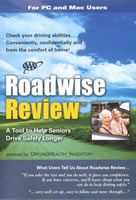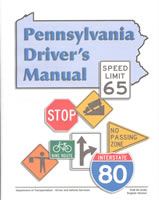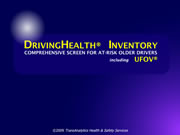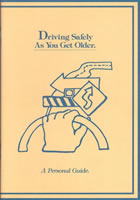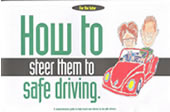Research Applications
Typically, the products of grants or contracts consist of data analyses or technical reports that satisfy a particular research objective defined by the sponsoring agency or client organization. In rare cases, a research product is designed to be used directly by the driving public. Alternately, the private sector may build on the outcomes of sponsored research to develop end-user applications. In the traffic safety arena, materials and software for driver education, testing, and training offer excellent examples of how new knowledge can be translated into products and services with immediate benefits for consumers.
TransAnalytics has produced the educational and training materials shown at right. These were geared to high-risk driver groups—teens and seniors—plus the Driver’s Manual distributed to over 200,000 first-time licensees in Pennsylvania each year. A second-generation product derived from the DrivingHealth Inventory screening software is now in use by multiple State DMVs as a tool to help evaluate medical fitness to drive.
AAA Roadwise Review™
Roadwise Review is an easy-to-use program on CD-ROM and available online that shows how age-related changes in visual, mental, and physical capabilities affect driving. It delivers immediate and confidential feedback on performance in the eight key areas that predict crash risk for older adults, as identified by health and driving experts in the largest scientific study of its kind ever conducted in the U.S. This self-screening program can be used on home computers to gain awareness of these ‘safe driving’ abilities. And Roadwise Review provides suggestions to help seniors keep driving safely longer that are tailored to each individual who uses this program.
All elements of this innovative consumer product – the narrative, still images and video, as well as the computer-based screening measures themselves – were developed by TransAnalytics.
To learn how to access Roadwise Review, visit the following url:
http://www.aaafoundation.org/resources/index.cfm?button=RoadwiseOnline
DrivingHealth® Inventory
Though we often take it for granted, driving a car is the most demanding — and the most risky — thing we do in our everyday lives. And in our society today, driving is more of a necessity than ever. Even our very oldest citizens rely on private automobiles well over 90 percent of the time to meet their essential mobility needs and to remain active in their communities. If we couldn’t drive, our quality of life would suffer immeasurably.
To maintain the independence that a car provides, without extra risk to ourselves and others, depends upon maintaining our ‘driving health.’ A person with good ‘driving health’ retains all of the critical visual, mental, and physical abilities needed to drive safely.
The DrivingHealth® Inventory provides a practical, PC-based tool to reliably measure the most critical safe driving abilities. Designed by TransAnalytics for rapid test administration in diverse office settings, this software offers flexible control over standardized procedures that have been validated against at-fault crashes in the largest scientific study of its kind in the U.S. Advanced data management capabilities make it easy to import screening results to a spreadsheet or database, to track changes over time. This software may be distributed and run on portable media, or via the Internet.
More information about the DrivingHealth® Inventory is available at the following url:
How to Steer Them to Safe Driving:
A tutor’s guide for Pennsylvania’s GDL program
Graduated driver licensing, or GDL, is properly credited with impressive gains in safety for novice, teen drivers in the large majority of states in the U.S. where such programs are in place. A key element of GDL programs is the requirement for a specified number of hours of supervised driving, where a parent or other experienced adult operator accompanies the novice as he or she is gradually exposed to more diverse, and more challenging, driving situations.
Teaching teenagers to drive takes time and patience. To get them familiar with all the situations they might face – and give them enough on-the-road experience to deal with each situation safely and confidently – takes many hours of instruction and practice. This tutor’s guide helps the supervising adult organize this practice, so that an appropriate amount of time is spent on how to handle a vehicle in a wide variety of situations, and to track what lessons have already been covered and decide what to review or cover next. Tips on how to communicate effectively with teens about driving safely are also provided in this guide.
The tutor’s guide, authored by TransAnalytics for the Pennsylvania Department of Transportation, may be accessed at the following url:
http://www.dot3.state.pa.us/pdotforms/young_drivers/tutorsguide.pdf
Pennsylvania Driver’s Manual
Approximately 200,000 knowledge examinations for driver licensure are carried out in Pennsylvania every year. The PA Driver’s Manual covers the traffic laws, traffic operations, and rules of the road an applicant will need to know to obtain a Pennsylvania driver’s license. It may be used by first-time applicants, to study for the driver’s examination; and by drivers who already hold a license to review information they may have forgotten, or to learn about rules of the road that are new or have changed since they were first licensed.
The 2006 edition of the PA Driver’s Manual includes expanded material on human factors and driving safety. It was written with a special emphasis on situations where crashes involving young, novice drivers occur and the types of driving errors they commit in those situations.
This resource, authored by TransAnalytics for the Pennsylvania Department of Transportation, may be accessed at the following url:
http://www.dmv.state.pa.us/drivers_manual/pa_driversman.shtml
Driving Safely As You Get Older: A Personal Guide
As the years go by, our abilities naturally change. Some things improve, as we learn from experience. At the same time, our vision isn’t as sharp, our reactions aren’t as fast, and we may not be able to concentrate as well. And it can be frustrating when changes in our abilities affect something as important to our quality of life as driving a car.
We want to be able to drive when we want to – and to do it safely. This means being able to handle any traffic situation we get into. Or, we need to stay away from those we can’t handle. In other words, we need to learn what our limitations are and then adjust how, when, and where we drive.
This booklet shows how to test the visual, mental, and physical abilities that determine how well we drive, and that are likely to change as we age. It suggests ways to deal with any limitations. It also includes tips on using the wide array of safety features in today’s automobiles, while providing other information and resources to help people keep driving safely longer.
To access this guide, authored by TransAnalytics for the Pennsylvania Department of Transportation, click here.
Teen AUTOfocus: Killer Curves™
The most frequent crash type for beginning drivers is a single-vehicle run-off-the-road crash. This happens most often on curves. To safely negotiate highway curves, drivers must behave in accordance with certain laws of physics—whether they think about the situation in those terms or not. Speed control is crucial, before entering a curve; so is properly positioning the vehicle in the lane, while scanning far enough ahead for the visual guidance needed to steer smoothly through the curve without mid-course corrections.
There are many formal and informal cues that tell drivers what to expect about a curve. Advance signs give a warning about how sharp it is, while drivers learn from experience how varying weather and surface conditions affect safe speeds. TransAnalytics has incorporated engaging graphics and video elements into “Killer Curves,” a 20-minute lesson that teaches novice drivers to see the signs, read the road, and brake straight when they encounter highway curves.
To view this multimedia lesson for safe driving on curves, visit the following url: http://www.teenautofocus.com/
This teen safety lesson was reviewed in 2008 by DETA, the association of Driving Education and Training Administrators.
